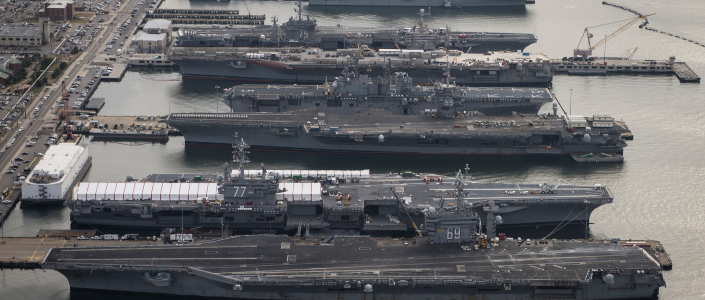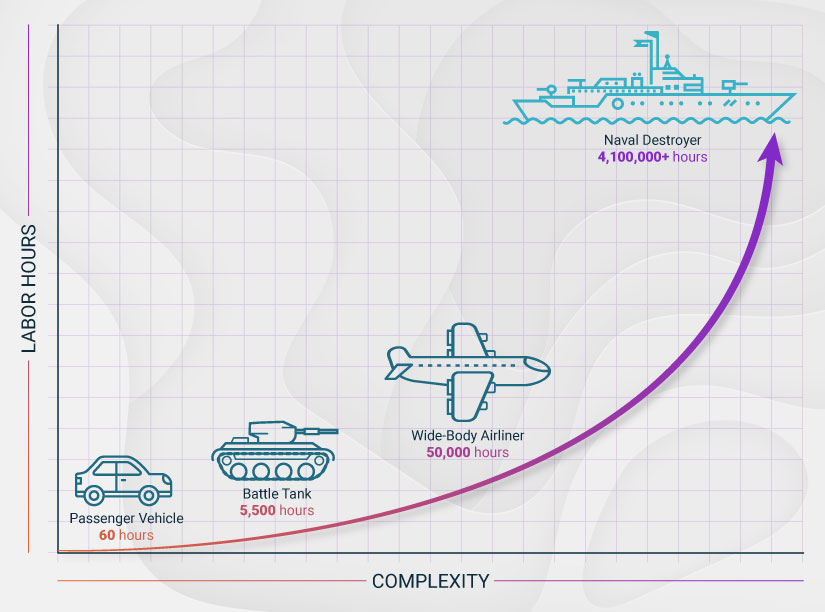
The holy grail for any shipyard is to have an ironclad solution to managing sister ships. For those not in the shipbuilding industry, sister ships are a series of ships that are “virtually” the same. In shipbuilding, we also use the term “Hull Effectivity”. As with other industries, each sister ship is not identical. There is as much as a 40% difference between the ships in the series with the highest degree of difference being between the first and last ship built. The shape of the hull and the superstructure may be the same, but all the internal systems and even structure can be significantly different.
Managing of multiple designs which are “similar” but not identical is a common challenge in many industries. There are general CAD solutions that suggest they have the answer to this very hard and complex problem. I am familiar with many of them and some have really good and creative solutions, but unfortunately I think they fall short of what our industry needs. There are unique traits only in shipbuilding that make managing the multiple designs of ships, orders of magnitude more difficult. There is always a comparison to the aerospace industry which I very much appreciate because the complexity of planes allows me to travel the world 35,000 ft. in the air safely. But the business of aerospace is different than the business of shipbuilding.
Shipbuilding Brings Series Management to a Whole New Level
There are many unique characteristics of shipbuilding which takes this to a whole new level. I believe the top three are:
- Profitability of Series Products Sooner
- Orders of Magnitude More Parts
- Engineering, Design, Planning, Procurement and Construction in Parallel
1. Profitability of Series Products Sooner
In shipbuilding, it is not common for a contract to call out for multiple vessels. However, when it happens, the quantity is usually a single digit. By contrast, in aerospace or automotive production, the quantity is much higher. This is significant difference as it will require shipbuilders to make a profit on the ships they build much earlier. Boeing, for example, does not plan to make a profit on their new Dreamliner until after selling 1100 planes. This allows other industries the “luxury” of more time to recoup money from the initial products.
2. Orders of Magnitude More Parts

The number of parts in shipbuilding is orders of magnitude higher than even the most complex airplane. I will not argue that a ship is a more complex engineering project; however, the vast more amount of parts does complicate solving the managing of series products. It is similar to comparing a modern cell phone to a modern airplane. Both are complex products but the amount of parts in an airplane does result in a high degree of complexity of management compared to a cell phone.
3. Engineering, Design, Planning, Procurement and Construction in Parallel
One of the biggest differences with shipbuilding compared to other industries is that engineering, design, planning, procurement and construction are happening at the exact same time. I have blogged about this before: What is the Biggest Challenge in Shipbuilding?
It is common that the engineering, design, procurement and construction is not even half way completed for the first ship before the second ship is being started. For those non-shipbuilders, I know, it is absolutely crazy. However, this is the reality of the industry and is probably the biggest reason why shipbuilding is so different compared to other industries.
Managing Change is the Difficult Part
The area that is very difficult in shipbuilding is managing change. With a multi-ship project, this problem exponentially increases and is why it is the hardest problem in shipbuilding.
The client or engineering team may make changes to improve the design and the production floor may also make changes to fix a costly production issue. All these changes are required to be applied to multiple ships. Since each ship is at different stages, the resulting change may be different. For example, a modification may need to be made to an area that has already been constructed on one ship. A change here might be a “quick” fix (which is not ideal), but will still resolve the issue. A different solution may be required for another ship which has not started construction in that area, but has all the material cut and purchased. The next ship, which is still in design, may have the “proper” fix applied to the design and therefore, all follow-on ships will also get the same implementation to resolve that change.
That was the easy part. When implementing change for any item you cannot work in isolation. Even though the item that you are working on is exactly the same in all ships, this does not mean that the change you make to that item can be applied to all ships. There are other changes with other items in specific ships that can affect what you plan to change. You will need to view your change with the configuration of all other ships with all surrounding items.
Again, this challenge is similar with other industries; however, with the sheer number of parts, change requests (ECNs), and the fact that each ship is at a different stage of engineering, design, procurement and construction, make managing the changes extremely difficult.
Technology is not the Issue; User Experience (UX) Is
There are many shipbuilding specific solutions in the market that understand the problem and have the technology to solve it. I think most have the technology and have implemented a solution in their portfolio of products that solve some of the issues with managing sister ships. However, I would say the problem is not completely solved by anyone.
The main reason I believe this is so is that in the past, most have been looking at solving this purely by technology and forgetting how the user will interact with the system. As described above, managing change in this very dynamic environment of shipbuilding will require a very good user experience to simplify the complexity of sister ships.
Solving this complex problem requires an easy and an intuitive solution that the user can quickly:
- Understand at what state each of the ships are in, to determine the type of fix that should be applied;
- Understand the impact of change in each ship since the change will have a different impact for each ship depending on which phase it is in;
- Have a representation of each ship prior/during/after making the change. This is so that the user can determine if they can optimize the design for multiple ships or if unique designs are required;
- Apply a change to multiple ships that are in different stages;
- Apply a change to multiple ships that can leverage the exact same design change;
- Verify the change is valid for all ships;
Many of the use cases which are presented by CAD and Shipbuilding solution providers use a simple scenario. This is essential to be able to convey the solution strategy to the user; however, some solutions do not scale very well. It is the similar case with using Excel to manage BOMs or change orders. If you only have a small number of items and changes, you can get away with Excel. When the project gets larger and you have many more parts, changes, suppliers and stakeholders using Excel does not provide you the user experience(UX) you need.
When managing sister ships, having a good User Experience (UX) is essential to ensure you are making the best decisions.
Closing Remarks
Managing sister ships is the hardest problem for any shipbuilder. They all are looking for an easy and intuitive solution that scales well in reality.
The uniqueness of shipbuilding makes the problem much more difficult. Factors include: the single digit number of sister ships, significantly more parts than other large manufacturing products and the fact that shipbuilding will engineer, design, procure material and construct at the exact same time with every sister ship being in their own phase.
The majority of the shipbuilding tools have the technology to provide a solution; however, they do not provide a good user experience to understand, implement and verify their changes on all needed ships. A solution to this difficult problem must provide all the different types of users a clear and concise view of what needs to be done on each ship as well as provide them a way to verify their change on all follow-on ships.


Post Comments
I guess this problem will vary depending on where ships are built. In Japan the shipbuilders have almost reached the limits of automation (and hence minimisation of human labour input), and in fact that has been the case for quite a while. I remember being involved in a newbuilding order at a Japanese yard for a foreign buyer. The ships in question were from a standardised series, but, despite knowing that, the buyers wanted to make some very small changes and were astonished by the costs quoted. I remember that one request was to change the TV’s to ones with larger screens in the officers’ and crews’ mess, for which they were quoted around US$20,000 (at a time when the actual cost of larger TV’s was less than US$1,000). When they queried the figure, they were told that many of the plans would have to be redrawn and other changes made to the specifications.
I would be astonished to hear that anyone ever ordered a ‘series’ ship from Japan with 40% changes from the original!
Thanks for your comments.
You are very right that Japanese yards usual do not have very much difference between ships in their series. For each change there are significant costs associated with them which deter changes. There are also other yards which have the same philosophy as the Japanese of keeping their ships as similar as possible. However, from what I understand the last few years which has hit the entire shipbuilding industry hard has seen even the Japan and Korean companies allow more changes than usual. What the future holds is unknown.
Yes, the poor market has led to a lot of competition for the few orders that are available, and yards have had to become more flexible in order to succeed. Additionally, Chinese yards have been scrambling for market share and are prepared to offer more flexibility in order to get established. As you say, we don’t know what the future holds; it will be interesting to see. There do seem to be signs of a return to ordering (in the dry cargo and tanker sectors anyway), so we may start to see quite soon!
Very well writing article… Thanks for sharing!
Sangat menginspirasi, semoga bisa terus berbagi dan berguna
salam hangat,
http://www.velascoindonesia.com